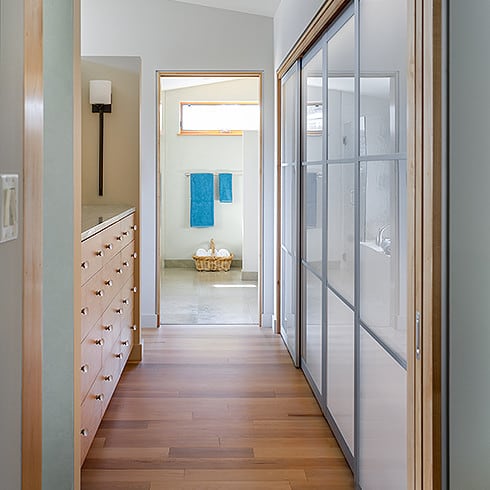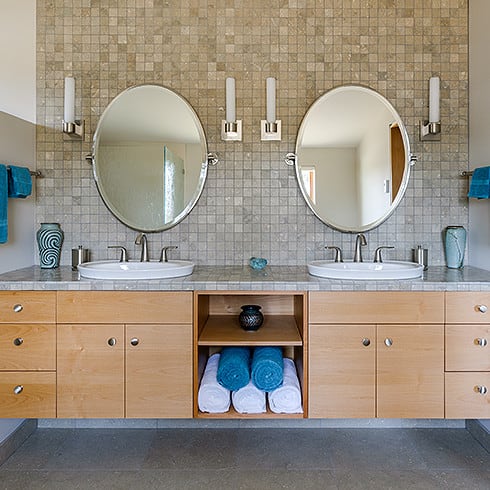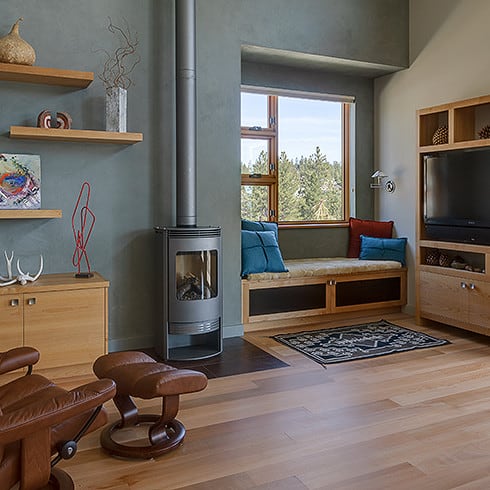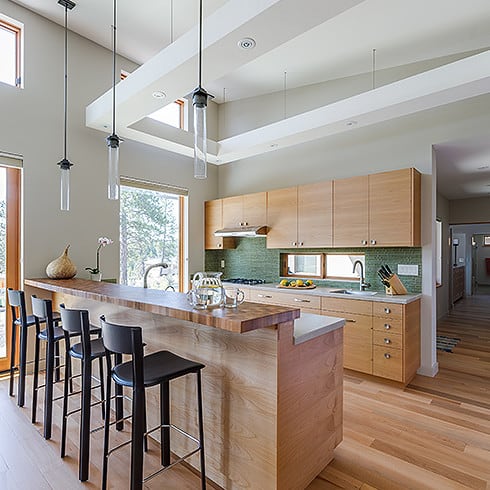This issue of Radiant Architecture features the Harbin Residence, a modern, super energy-efficient home located in Bend, Oregon. The home was designed for the long term, with a vision for the changing living requirements of an aging homeowner (often referred to as Aging in Place).
Designing For Her Future in Bend, Oregon

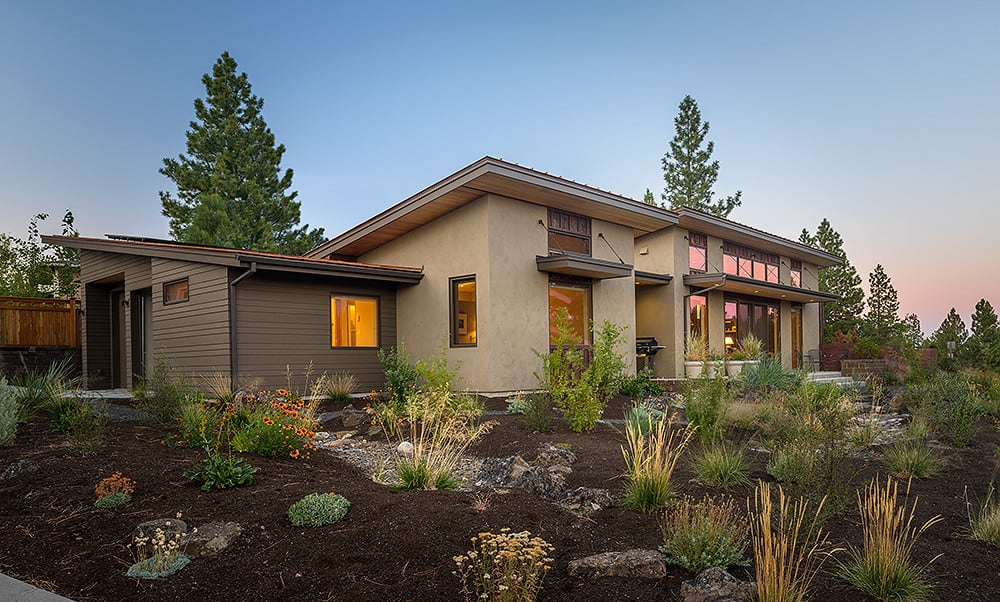
Some of these design features include the absence of interior thresholds, minimal transitions, a garage flush with the rest of the home, and wide halls and doorways. The home has received impressive ratings and accolades for its efficiency. It is a Certified Oregon High Performance Home and rated Platinum through Oregon’s Earth Advantage Program. The Harbin Residence also has the distinction of winning the People’s Choice Award in the 2012 Central Oregon’s Green + Solar Tour.
Type:
New residential construction
Location:
Bend, Oregon
Total Square Footage:
2,000 square feet
Lot Size:
8,112 square feet
Floor Covering:
Oregon Madrone wood floor and tile
Energy:
95% efficient gas boiler
Architect
Cheryl Heinrichs
With offices located in Bend, Oregon and Olympia, Washington, Cheryl Heinrichs Architecture has long been recognized for their commitment to sustainability, innovation and design excellence. CHA’s 17 year dedication to environmental preservation combined with their signature style of elegant, modern design allows clients to live comfortably in their inspired, efficient, and healthy homes.
“The Harbin Residence was a very gratifying project because I worked with a homeowner who desired a modern home, was open to a few added surprises I dreamed up and requested a very high level of energy efficiency. The home is filled with sunshine and fresh air and possesses a rich indoor/outdoor connection while being nestled into the site. The finishes are simple and natural and many were selected because of their long lasting and zero maintenance attributes. Some of these include stucco with integrated color, metal roofing and siding, concrete siding, metal clad windows, concrete patios, and tile counters and floors.
The shape of the home is made up of 3 simple shed roofs, but with 2 added design twists. The 2 large shed roofs face opposite directions and are intertwined where they pass by each other. The smaller shed roof, over the Master Bedroom, forms a butterfly roof with the shed room that covers the garage, master bath, and laundry/mudroom.
I love the amount of natural sunlight in this home, which we accomplished with a few measures. The main rooms are located on the South side of the house, where the sun spends the majority of its time. These rooms have large windows, doors, and high clearstories to capture a lot of sunlight. Interior walls between the great room and north side rooms are shortened, allowing light to pass over. All the rooms, except the guest room, bath and laundry, have windows on at least two walls. Even the garage has a few high windows.
In this project the homeowner explored the pros and cons of radiant heating and concluded that radiant was the best choice for her. As the homeowner and I worked through her needs and desires, we concluded that as she aged a slab-on-grade would feel hard under foot so she eliminated this option.
She had also decided that she wanted the majority of her flooring to be wood with the remainder being tile. Since both the builder and I had worked with Warmboard and found it easy to combine with these flooring materials, it became the obvious choice. The fact that Warmboard is so energy efficient also helped meet our performance goals for the home.
I enjoy working with Warmboard because finished wood floor can go directly on top of it. That makes things a lot easier! I also find that other methods of radiant heating are much more complicated than Warmboard. It really is a simple system and easy to design into any project.
I also appreciate that Warmboard makes it possible to use radiant heat over raised floor joists. Compared to concrete, raised joists are softer to walk on and easier on the homeowner’s joints. The subfloor and radiant panels are installed at the same time and the end result is a floor with some give and an exceptional home heating system.
This project was designed with an extended future in mind as well as super efficient performance. We were able to be creative to achieve these goals and had a lot of fun collaborating with both the homeowner and builder.”
Cheryl Heinrichs Architecture
Bend office 541-382-8914
Olympia office 360-350-0628
Cheryl [at] CHArchitecture.com
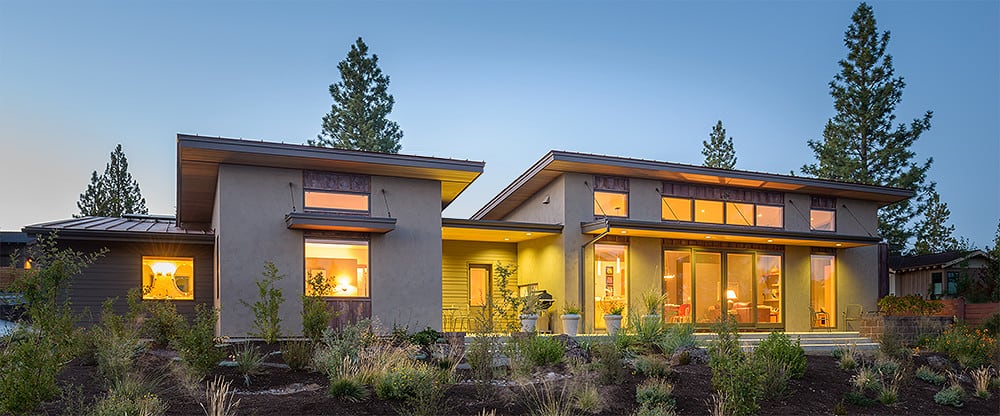
Builder
Jim Davis
JB Davis Construction builds with energy efficient materials and unique construction techniques that allow them to solve any challenge an architect throws their way. Jim prides himself on his company’s sustainable focus and the ease of incorporating energy efficient detailing into any project.
“The last 3 of 4 homes we built were for retiree-aged people so I was familiar with features that are important to this demographic of homeowners and the value and foresight of planning for future needs that may arise.
Harbin Residence utilized many systems and products to achieve its outstanding energy efficiency. Some of these include a tight, insulated shell (floor, wall, ceiling), effective natural ventilation and cooling, a 94% efficient, tankless on-demand hot water heater, high performance windows and exterior doors, a photovoltaic system, and a roof that will accommodate a solar hot water system and expansion to the PV system if desired in the future.
The home is also outfitted with a Warmboard radiant heating system that is used with a 95% efficient gas boiler. The most important factors to me regarding the heating system for this home was comfort, ease of use for the homeowner, and a high efficiency rating for the overall house performance. This project had high energy efficiency requirements because of the desire to hit the maximum ratings in the Earth Advantage program here in Oregon.
The past 8 out of 10 custom homes I have built have been radiant heated homes. I have done radiant in gypcrete and found it difficult because of the challenges that arise when using a variety of floor coverings and the accommodations that have to be made to make it work.
I really like Warmboard because of the ease of installation – it really is simple to install. I also like that it works great with differing flooring products and this is a big plus to me. It is very easy to incorporate Warmboard into custom homes because most times clients haven’t locked in finished floors, but I know with Warmboard whatever they ultimately decide on will work seamlessly.
The house was being finished during winter last year and we used the heating a lot. I found that the responsiveness of the Warmboard system was very impressive as it comes up to temp quickly and the floor was evenly heated. Warmboard’s response time is a big selling point for primary and second homes. In the case of a second home, homeowners can use the home away settings to bring the house up to temperature so it’s cozy and warm when they arrive. My experience with mass systems is that they can take up to a full day to heat up a cold home whereas Warmboard can do the same job in 3-4 hours. That is truly extraordinary.”
JB Davis Construction LLC
541-410-9934
Jim [at] JBDavisConstruction.com
Homeowner
Helen Harbin
“I was living in a multi-story home with a steep driveway and the home had some limitations so I began to look for a build site where I could have the home I wanted. I found the perfect site in Bend for my needs and decided to build the home to match. My goal was to have an efficient home that was also calming through the design, materials, and interior finishes used.
While learning about all the radiant options available, I watched Jim build another home using Warmboard and I absolutely loved the idea of it. I wanted radiant heating that was super simple and efficient and would complement the tight envelope of the home.
I had seen houses in my neighborhood using radiant in gypcrete, but I really wanted the comfort of having a wood subfloor. Concrete is too hard and uncomfortable to walk on and live with long term.
This is my first radiant heated home and compared to forced air I love it! By using Warmboard and having an insulated envelope my home is always the right temperature. I moved into my house in February 2012 and to date my Warmboard system works great! I am totally comfortable and to be honest I haven’t been aware of it – there is no noise and no blowing air so I think it’s working perfectly. It is also such a plus that the air never feels dry like it does when heating with forced air. The ultimate comfort I have in my home is my favorite thing about Warmboard.
Another important benefit of Warmboard that I love is how efficient it is and how low my energy bills are. When the cost is lower for heating your home you don’t worry about bumping the thermostat up a few degrees because you know the cost is so minimal.
I also really like the zoning ability of Warmboard. I like to keep my bedroom cooler, but have my master bathroom slightly warmer so I can truly control the environment throughout my house for my own temperature preferences.
I had also decided that I wanted hardwood and tile for all of the floor coverings. Warmboard was the only logical choice and worked seamlessly with my flooring selections.
In addition to the overall efficiency of the home and the comfort that Warmboard provides I am very happy with the amount of natural light throughout the house. I often feel like I am outside, but am nice and cozy inside. All of the windows allow me to enjoy the property and the open space surrounding my home.
I also really like that the home is one level and that the garage is flush with the rest of the home. It makes access to the home easy. This also gives me the ability to accommodate life changes that may arise in the future as the years go by.”
Radiant in the Fourth Dimension
Terry Alsberg, CEO of Warmboard
Good architects are always cognizant of “time,” or the fourth dimension. As the sun travels across the sky, and as artificial lighting replaces natural light, a home is constantly changing its appearance, hour by hour, season by season. Likewise, heating requirements also change, hour by hour, season by season. Materials change with time, with the better materials acquiring the rich patina of age over the years. Especially important to Ms. Harbin, were the changes in our bodies over time. In all of these respects, her home is an excellent example of an appreciation to the fourth dimension.
Radiant floor heat is an essential fourth dimension consideration. While a radiant system may cost three or more times the price of a forced air system, it would be wrong to rely solely on that comparison; accurate only for a single point in time when the construction is completed, and before a single heating bill has been paid. Ms. Harbin, like so many who choose radiant, expects to live in this home for a long time. Though there are many variables in play, the cost advantages of a forced air system disappear entirely in as little as seven years as operational costs creep in. Time is on the side of those who choose radiant.
The core function of a radiant system is to conduct heat from water in a tube to the surface of your floor. Conductivity is a measure of how much heat will flow through a material in a given amount of time. Using a thick aluminum plate to conduct heat speeds up the delivery process and allows for lower water temperatures which lowers energy usage, and energy bills.
With copious amounts of south facing glass, as in the Harbin project, a highly conductive quick response system is essential to prevent the energy waste of overheating in the afternoons, due to passive solar effects. Because of our thick aluminum’s fourth dimension advantage, the lowest heating bills are made possible, and the owner recovers initial installation costs more quickly. As economists talk of the time value of money, an energy efficient, high conductivity radiant system makes that time value more tangible.
A healthy environment has a very positive effect on our bodies over time. Ms. Heinrichs designed this home on a single level with transitions from the garage and other entry points to accommodate a time when mobility may be limited.
Ms. Harbin was particularly sensitive to the hard, unyielding nature of a slab floor construction and the slow damage it could inflict on her joints. Choosing the more friendly, framed floor radiant option means delaying any eventual need of a walker or wheelchair. The clean air, quiet and peaceful environment made possible by radiant is another factor in a longer, higher quality life.
Warmboard’s superior conductivity provides a host of fourth dimension benefits. Consistent temperatures and humidity conditions, clean air, a perfectly silent heating system; these all contribute to a long and healthy life in a home that can be enjoyed as time goes by, for many years to come.
